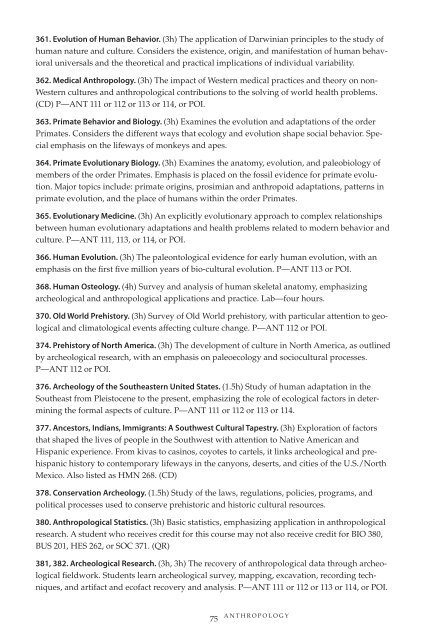theundergraduateschoo ls - Wake Forest University
theundergraduateschoo ls - Wake Forest University
theundergraduateschoo ls - Wake Forest University
Create successful ePaper yourself
Turn your PDF publications into a flip-book with our unique Google optimized e-Paper software.
361. Evolution of Human Behavior. (3h) The application of Darwinian principles to the study of<br />
human nature and culture. Considers the existence, origin, and manifestation of human behavioral<br />
universa<strong>ls</strong> and the theoretical and practical implications of individual variability.<br />
362. Medical Anthropology. (3h) The impact of Western medical practices and theory on non-<br />
Western cultures and anthropological contributions to the solving of world health problems.<br />
(CD) P—ANT 111 or 112 or 113 or 114, or POI.<br />
363. Primate Behavior and Biology. (3h) Examines the evolution and adaptations of the order<br />
Primates. Considers the different ways that ecology and evolution shape social behavior. Special<br />
emphasis on the lifeways of monkeys and apes.<br />
364. Primate Evolutionary Biology. (3h) Examines the anatomy, evolution, and paleobiology of<br />
members of the order Primates. Emphasis is placed on the fossil evidence for primate evolution.<br />
Major topics include: primate origins, prosimian and anthropoid adaptations, patterns in<br />
primate evolution, and the place of humans within the order Primates.<br />
365. Evolutionary Medicine. (3h) An explicitly evolutionary approach to complex relationships<br />
between human evolutionary adaptations and health problems related to modern behavior and<br />
culture. P—ANT 111, 113, or 114, or POI.<br />
366. Human Evolution. (3h) The paleontological evidence for early human evolution, with an<br />
emphasis on the first five million years of bio-cultural evolution. P—ANT 113 or POI.<br />
368. Human Osteology. (4h) Survey and analysis of human skeletal anatomy, emphasizing<br />
archeological and anthropological applications and practice. Lab—four hours.<br />
370. Old World Prehistory. (3h) Survey of Old World prehistory, with particular attention to geological<br />
and climatological events affecting culture change. P—ANT 112 or POI.<br />
374. Prehistory of North America. (3h) The development of culture in North America, as outlined<br />
by archeological research, with an emphasis on paleoecology and sociocultural processes.<br />
P—ANT 112 or POI.<br />
376. Archeology of the Southeastern United States. (1.5h) Study of human adaptation in the<br />
Southeast from Pleistocene to the present, emphasizing the role of ecological factors in determining<br />
the formal aspects of culture. P—ANT 111 or 112 or 113 or 114.<br />
377. Ancestors, Indians, Immigrants: A Southwest Cultural Tapestry. (3h) Exploration of factors<br />
that shaped the lives of people in the Southwest with attention to Native American and<br />
Hispanic experience. From kivas to casinos, coyotes to carte<strong>ls</strong>, it links archeological and prehispanic<br />
history to contemporary lifeways in the canyons, deserts, and cities of the U.S./North<br />
Mexico. A<strong>ls</strong>o listed as HMN 268. (CD)<br />
378. Conservation Archeology. (1.5h) Study of the laws, regulations, policies, programs, and<br />
political processes used to conserve prehistoric and historic cultural resources.<br />
380. Anthropological Statistics. (3h) Basic statistics, emphasizing application in anthropological<br />
research. A student who receives credit for this course may not a<strong>ls</strong>o receive credit for BIO 380,<br />
BUS 201, HES 262, or SOC 371. (QR)<br />
381, 382. Archeological Research. (3h, 3h) The recovery of anthropological data through archeological<br />
fieldwork. Students learn archeological survey, mapping, excavation, recording techniques,<br />
and artifact and ecofact recovery and analysis. P—ANT 111 or 112 or 113 or 114, or POI.<br />
A N T H R O P O L O G Y<br />
75






